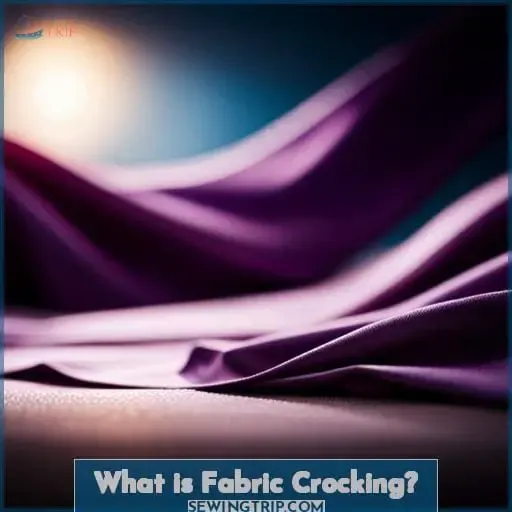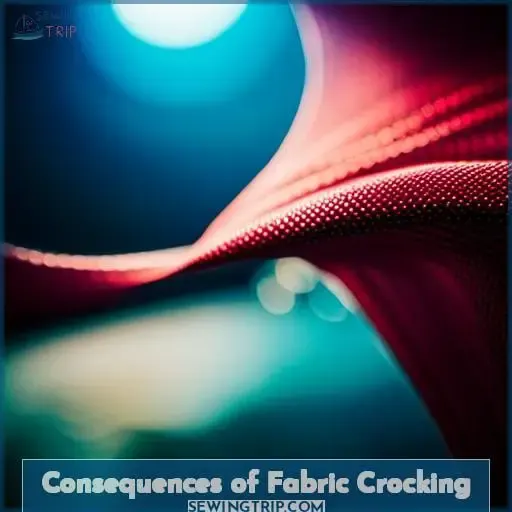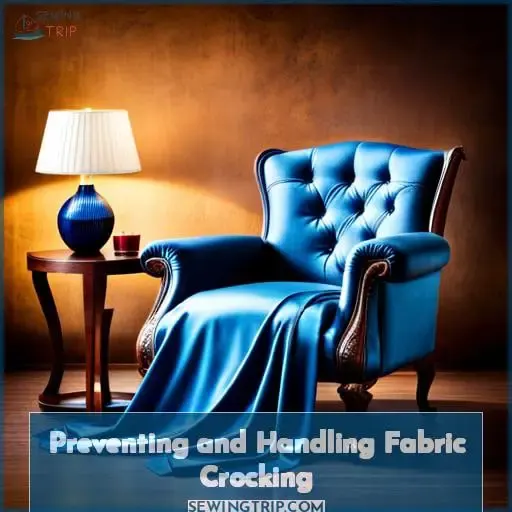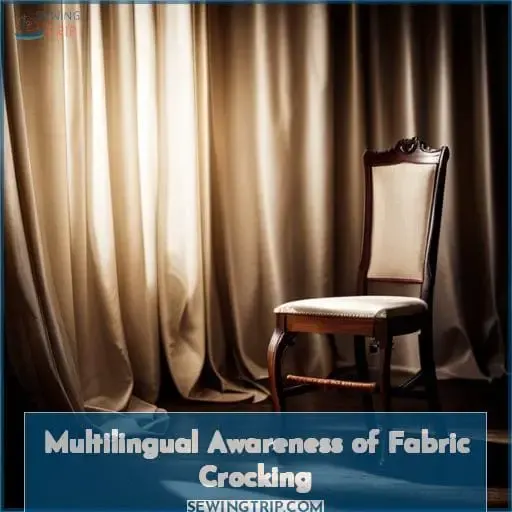This site is supported by our readers. We may earn a commission, at no cost to you, if you purchase through links.
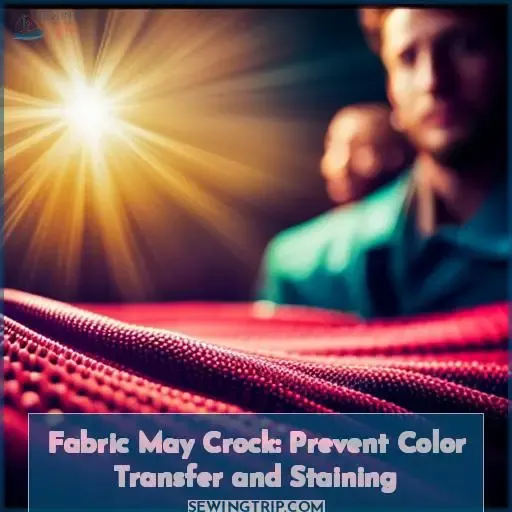 Imagine a world where colors run wild, leaving stains and marks wherever they go.
Imagine a world where colors run wild, leaving stains and marks wherever they go.
Have you ever come across the warning fabric may crock? Don’t fret! This article will unveil the secrets behind fabric crocking and provide you with essential tips to prevent color transfer and staining.
So get ready to dive into the colorful world of textiles as we empower you with knowledge for safer fashion choices.
Table Of Contents
Key Takeaways
- Fabric crocking is the transfer of dye from one fabric to another, often caused by excess dye or improper dyeing methods.
- Testing methods like the Crockmeter help evaluate the degree of color transfer, indicating poorly dyed fabric with a high risk of crocking.
- Fabric crocking can lead to staining, fading of the fabric, reduced garment longevity, and frustration for consumers.
- Preventive measures such as following care instructions, avoiding vinegar or salt in the wash, and testing for colorfastness can help minimize fabric crocking.
What is Fabric Crocking?
Fabric crocking, also known as color transfer, is a common issue in textiles where the dye rubs off onto other fabrics or objects. It occurs when the fabric comes into contact with moisture or friction, even when dry.
Crocking can be caused by poor dye quality or improper dyeing methods and can lead to staining and color fading if not properly addressed.
Definition and Causes of Crocking
Fabric crocking occurs when color rubs off a fabric due to abrasion. It’s important to understand the definition and causes of crocking to prevent color transfer and staining.
- Crocking can result from factors like excess dye or improper dyeing in fabrics.
- Fabrics with lighter colors or designs on the reverse side are more susceptible.
- Testing methods, such as using a Crockmeter, help evaluate the degree of transfer in textiles.
Synonyms and Translations
One common term for fabric crocking, which refers to color rubbing off due to abrasion, is known as crocking.
Synonyms in different languages include:
Rubbing, Transfer, Smear and Spread.
Translations of the term ‘crocking’ can be found in various languages such as:
French: Crocking
Spanish: Crocking
Portuguese: Crockinng
and more.
Multilingual awareness of these terms is essential for global markets and cultural significance highlights the impact language has on understanding fabric crocking.
The Significance of the Fabric May Crock Warning
When you come across a fabric with a fabric may crock warning, it’s important to understand the significance behind it.
This warning indicates that the fabric hasn’t been properly dyed and there’s a high risk of color transfer onto other fabrics or objects.
It serves as an alert for consumers to take precautions in handling, washing, and wearing the fabric to prevent staining and color fading.
Implications of Poor Dyeing Quality
When encountering fabric that may crock, it’s essential to understand the implications of poor dyeing quality. Poorly dyed fabric can lead to color transfer and staining, causing frustration and inconvenience.
Importance of Colorfastness
To understand the significance of the fabric may crock warning, recognize the importance of colorfastness.
It ensures that fabric dyeing quality is high and prevents color transfer.
Follow crocking care tips, use multilingual labeling, and prioritize colorfastness to prevent staining.
Care and Precautions
To ensure the longevity and colorfastness of your fabrics, understand the significance of the Fabric May Crock warning.
- Follow care instructions
- Wash similar colors together
- Handle fabric with caution to prevent rubbing
- Use proper drying techniques for stain prevention
- Be mindful when wearing jeans or indigo-dyed items
Consequences of Fabric Crocking
When fabric crocks, it can have serious consequences for both the garment and the wearer.
The most immediate consequence is color transfer to other fabrics, leading to staining and discoloration.
This can be frustrating and inconvenient, requiring special care during washing and wearing.
Additionally, prolonged exposure to crocking may result in fading of the fabric’s original color and reduced fabric longevity over time.
Color Transfer and Staining
To prevent color transfer and staining caused by fabric crocking, you need to be aware of the potential consequences.
- Prioritize colorfastness in your fabric selection.
- Follow proper fabric care instructions to minimize dye transfer.
- Use stain prevention techniques such as pre-treating stains before washing.
- Look for multilingual labels that provide information on crocking and stain resistance.
By taking these precautions, you can maintain the integrity of your textiles and avoid unsightly color transfers or stains caused by fabric crocking.
Frustration and Inconvenience
When fabric crocks, frustration and inconvenience ensue as color transfers onto other fabrics or objects. This can be caused by friction between materials, resulting in unwanted stains. However, solutions exist to combat these frustrations and prevent further color transfer.
Potential Fabric Fading and Reduced Longevity
Fabric crocking can result in the potential fading of fabric and a reduced lifespan for your garments.
- Wash similar colors together to minimize color transfer.
- Use oxygen bleach to clean crocking stains.
- Avoid direct sunlight and dryers to prevent fading.
- Consider using color fixatives for fading prevention.
5.Test fabrics according to AATCC 165 test method for potential fabric fading risk assessment
Preventing and Handling Fabric Crocking
To prevent and handle fabric crocking, it’s important to follow proper washing and care instructions provided by the manufacturer.
This includes avoiding the use of vinegar or salt during the wash cycle, as they only work during the dyeing process.
Additionally, consider using color-catching sheets in your washing machine to minimize color transfer.
Finally, always test for colorfastness before using any fabric for DIY projects to ensure that it won’t crock when subjected to friction or abrasion.
Washing and Care Instructions
When washing and caring for fabrics prone to crocking, follow specific instructions to prevent color transfer and staining.
Use gentle washing techniques, avoid chlorine bleach, and be cautious with pile fabrics or those with surface dye.
Using Color-Catching Sheets
To prevent color transfer and staining, protect your fabrics by using color-catching sheets.
These sheets are designed to absorb loose dye in the wash water, preventing it from transferring onto other fabrics.
They’re a great tool for fabric preservation and stain prevention.
Testing for Colorfastness
To prevent and handle fabric crocking, you can test for colorfastness.
Colorfastness testing ensures that the dye doesn’t transfer onto other fabrics or objects, preventing stains and maintaining fabric quality assurance. It’s crucial in dye transfer prevention for art materials and museum of fine arts exhibitions.
Multilingual Awareness of Fabric Crocking
For global markets, it’s important to have multilingual awareness of fabric crocking in order to prevent color transfer and staining. This ensures that consumers worldwide are educated about the potential risks associated with certain fabrics.
- Global Awareness: By providing information in different languages, manufacturers can reach a wider audience and ensure that everyone understands the importance of preventing fabric crocking.
- Language Labels: Multilingual labels on clothing items can help consumers identify fabrics that are prone to color transfer and take necessary precautions during washing and wearing.
- Consumer Education: Through multilingual resources, consumers can learn about proper care techniques for different types of fabrics, reducing the risk of color bleeding or staining.
- Multilingual Precautions: Fabric quality varies across cultures; therefore, multinational textile companies must consider cultural differences when educating customers globally about how best avoid color transference issues while using their products.
Frequently Asked Questions (FAQs)
How can I determine if a fabric is prone to crocking before purchasing it?
To determine if a fabric is prone to crocking before purchasing, look for colorfastness labels and perform a wet crocking test by rubbing the material against white cloth.
Can crocking be prevented by washing the fabric multiple times before use?
Multiple washes before use can help remove loose dye from fabric, reducing the risk of crocking. However, it’s important to note that some crocking may still occur despite your efforts.
Are there any specific fabrics or colors that are more likely to crock?
Certain fabrics, such as dark-colored or heavily pigmented ones, are more likely to crock.
Fabrics with loose dye or improper dyeing methods can also increase the risk.
Take precautions when using these fabrics to prevent color transfer and staining.
What should I do if my fabric has already crocked onto another fabric or object?
If your fabric has already crocked onto another fabric or object, act quickly.
Gently blot the stain with a color-safe stain remover or mild detergent.
Avoid rubbing, as it may spread the dye further.
Are there any home remedies or DIY solutions to fix or prevent crocking?
To fix or prevent crocking, consider using commercial color fixatives.
Wash similar colors together and minimize excessive movements to reduce friction.
Avoid vinegar or salt during the wash cycle, and treat stains promptly for best results.
Conclusion
In the vibrant world of textiles, the threat of fabric crocking looms large. Understanding the causes and consequences of color transfer and staining is essential for maintaining the longevity of your garments.
By following proper care instructions, using color-catching sheets, and testing for colorfastness, you can prevent the frustration and inconvenience of fabric crocking.
So, next time you encounter the warning that fabric may crock, remember these tips to keep your fashion choices vibrant and stain-free.

